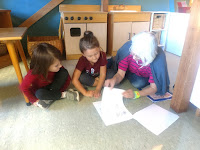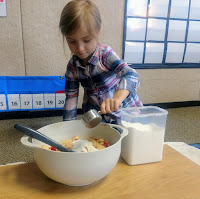We use a workshop model for our academic choice. I often use a read aloud or an example of student work to introduce a new choice or encourage conversation around how we can extend a choice.
For example;
What tools could we use as readers when working with kind notes?
Our name rocks to write a name.
Our alphabet chart.
Our sight words.
Our choices are ever evolving based on the interests and questions of the students as well as the learning occurring in our other workshops. It is important for children to transfer their developing literary skills across experiences, content areas, and into their exploration and play.
Examples from the Classroom
Kind Notes
LS is writing a kind note to her dog, Boo-Boo. She wants to write her dog's name. I ask her, what strategy can you use? We have written her dog's name before in her teaching book about Boo-Boo during writing workshop. I think she will suggest stretching out his name. Instead LS (the problem solver) rushes to our writing folders. She brings her folder to the table and finds her book about Boo-Boo, using her work from writing workshop to write her dog's name.
CB is writing a kind note to her mom. She starts by writing her name. We talk about the structure of a note; it has to be addressed to someone, like a letter. We can use sight words to write a kind note; to and love. RD and I check in about using the word to in his note to dad. I will be looking to see if both students use these sight words in their kind notes independently when they go back to finish their kind notes.

Cutting and Gluing
SW is working on adding labels to a collage she has developed using a picture of one of our favorite Jon Klassen characters; triangle. She is using our art scissors and shape punches to add detail to her work. How do you write triangle? She quickly uses one of our favorite writing strategies; find the word in a book! Using the book Triangle she adds labels to her collage.

Leaf Stamp
Our red leaf stamp is a new academic choice this week, following the work we did with the leaf stamp earlier this Fall. Using the stamp and the skill of outlining, students choosing Leaf Stamp are expected to write By- __________ at the top of their canvas. They are expected to take their time applying ink to the leaf stamp, push the stamp on to their canvas, and outline the leaf carefully.
Then, using our little color book RED, students write the repeating sentence on their work; The leaf is red. This supports their one-to-one correspondence, development of early reading skills, recognition of sight words, and foundational writing skills; sentence structure, letter printing, and word writing.
Small Building
SP uses sticky notes to add two labels to his small building design; bird and mountains. He represents a bird (owl) using gems, wooden leaves, and rocks. He uses gems to frame his work and triangle rocks to create the mountains. He uses his speaking and language skills to explain his work. I ask, What could you add to help tell your audience about your work? Labels!
The following choice I put up a picture of SP's work. What can we learn from SP?
We can add labels.
We can use books and the classroom and stretch words- just like we do during writing workshop.

Alphabet Puzzles
Literacy puzzles continue to be a favorite choice. We use them to develop letter ID and sound knowledge and we also use them to extend our work. On Friday the children working with literacy puzzles put one of our alphabet puzzles in the same order as our alphabet chart- alphabetical order. I suggested adding alphabet labels. How many sticky notes would you need? 26!
We gathered together and took turns pointing to and reading the alphabet. I offered a way to extend their exciting work- could we save the sticky notes and use them to create our own alphabet puzzle or book? BC and SP excitedly saved their sticky notes to use for the creation of an alphabet book the following choice.




















































































